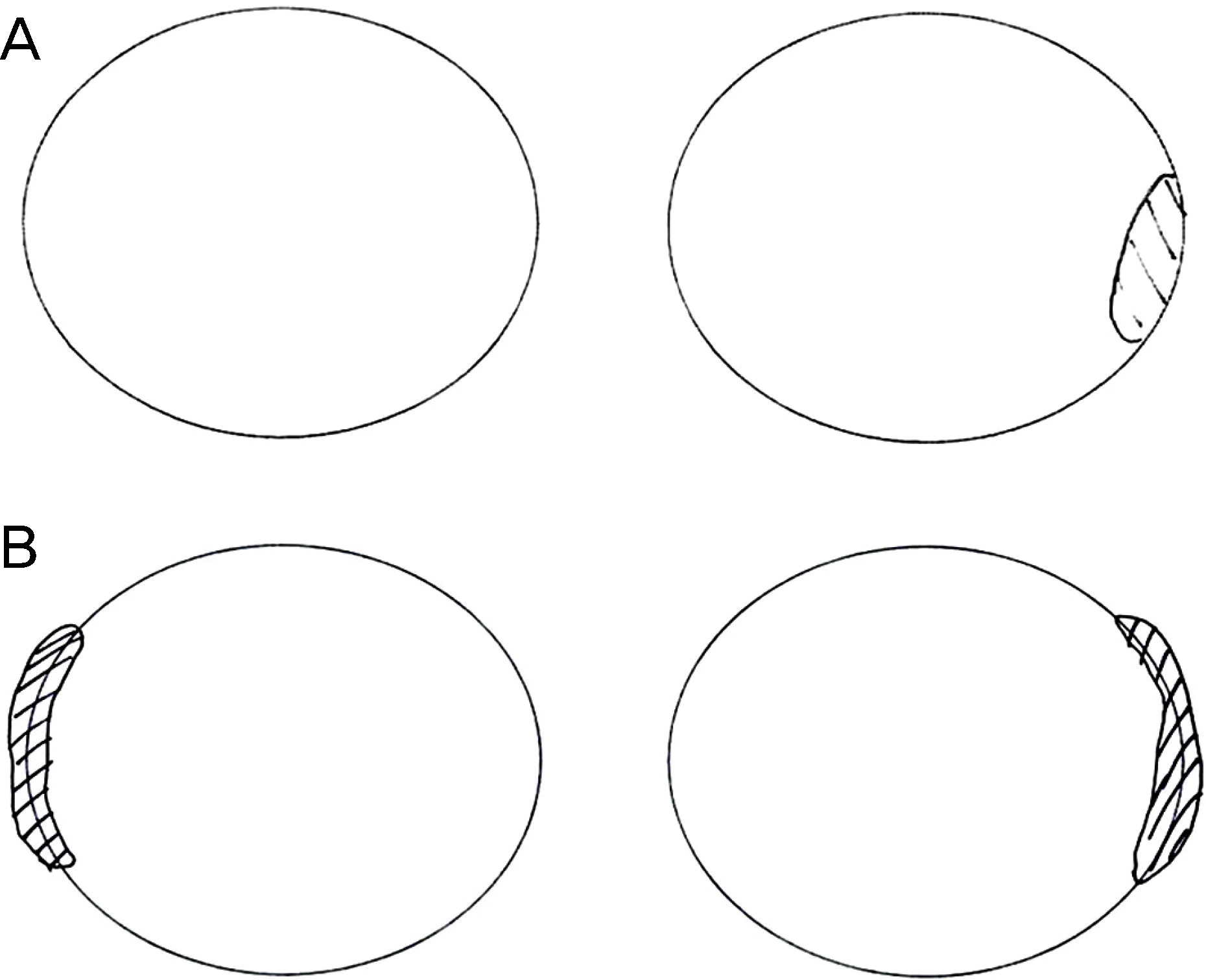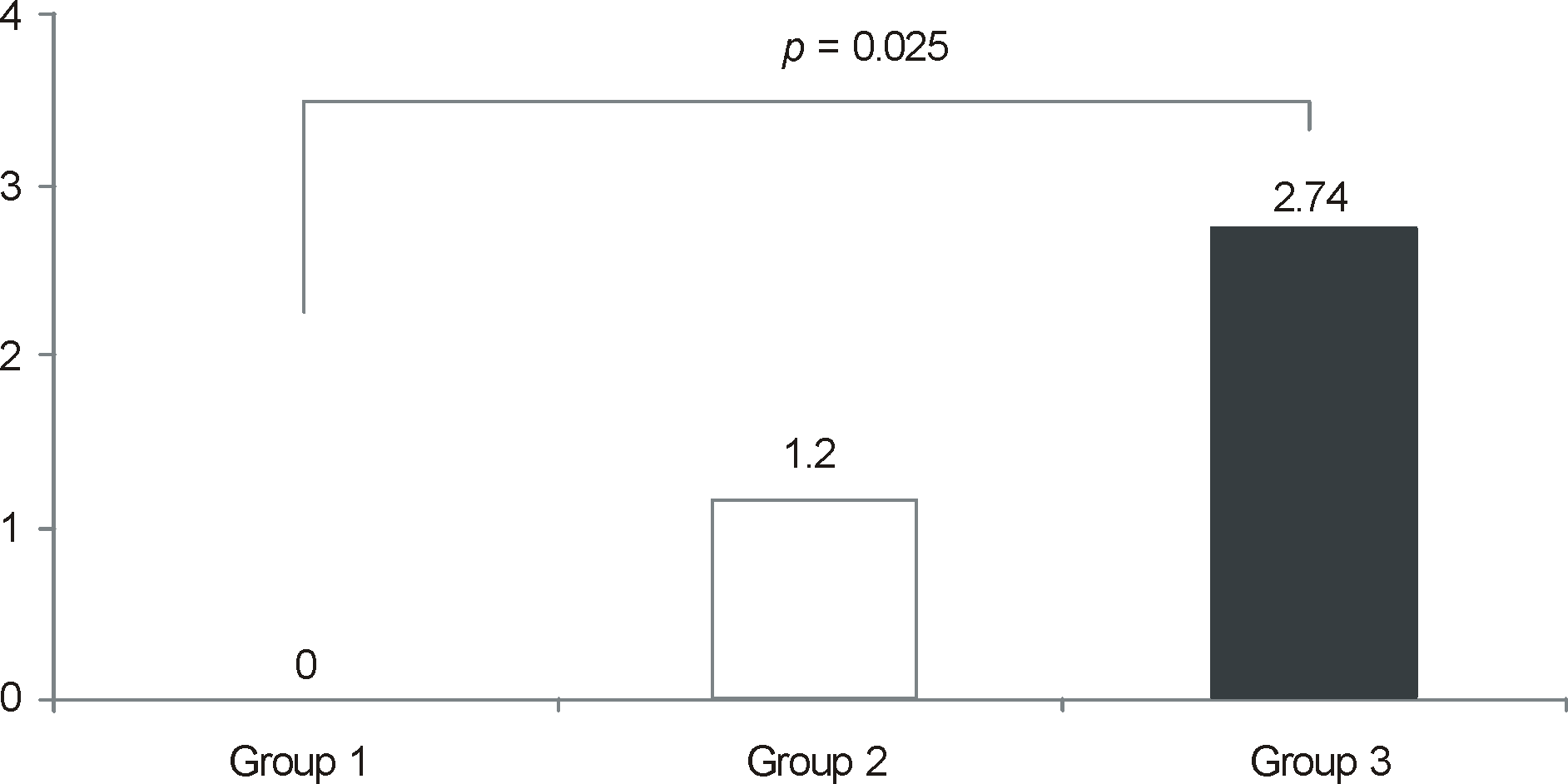Abstract
Purpose
Methods
Results
Conclusions
References
 | Figure 1.Negative dysphotopsia seen by patient in the temporal field. (A) Case 1 complained of a temporal dark shadow in her left eye 1 week after cataract surgery. (B) Case 7 complained of a semicircular shadow in her both eyes 1 month after cataract surgery. |
 | Figure 2.Prevalence of negative dysphotopsia according to implanted intraocular lens. Prevalence of negative dysphotopsia was different among the groups (p = 0.039, Fisher's exact test). Subgroup analysis showed that the prevalence of negative dysphotopsia in the group 3 is statistically higher than that of group 1 (p = 0.025, Fisher's exact test). However, there is no statistically significant difference of prevalence of negative dysphotopsia between the group 2 and group 3, and between the group 1 and group 2 (p = 0.122, 0.268, respectively, Fisher's exact test). Group 1 : who have never complained of negative dysphotopsia (Toric IOL, HOYA YA-60BB, HOYA PC-60AD, or Tecnis ZA9003); Group 2: who were implanted with Akreos Adapt AO; Group 3: who were implanted with Acrylsof® SN60WF. |
Table 1.
| No negative dysphotopsia group (1007) | Negative dysphotopsia group (13) | p-value | |
|---|---|---|---|
| Sex (M:F) | 338:669 (33.6%:66.4%) | 2:11 (15.4%:84.6%) | 0.239* |
| Age at operation (years) | 70.13 ± 22.66 (19-71) | 63.77 ± 6.41 (54-75) | 0.312† |
| Follow-up period (months) | 7.72 ± 7.18 (1-28) | 18.63 ± 10.98 (3-37) | <0.01‡ |
| Laterality (Right:Left) | 486:521 (48.4%:51.6%) | 6:7 (46.2%:53.8%) | 1.00† |
Table 2.
| Case | Age(years) | Sex | Laterality | Negative dysphotopsia | Onset of negative dysphotopsia | BCVA after surgery | ACD before surgery | Site of CCI | IOL type | HVF P60-4 | Nd:YAG laser anterior capsulotomy | Resolution after treatment | Spontaneous resolution* |
|---|---|---|---|---|---|---|---|---|---|---|---|---|---|
| 1 | 69 | F | Right | † | † | 0.00 | 2.58 | T | Akreos | Normal | † | † | † |
| Left |
Temporal dark shadow |
1 week | 0.00 | 2.58 | T | Akreos | Normal | ‡ | ‡ | No | |||
| 2 | 65 | F | Right | † | † | 0.00 | 1.83 | T | Akreos | § | † | † | † |
| Left |
Semicircular shadow |
1 week | 0.00 | 2.00 | T | Akreos | § | Yes | No | No | |||
| 3 | 54 | F | Left |
Semicircular shadow |
1 week | 0.00 | 3.39 | T | Akreos | Normal | Yes | No | No |
| 4 | 70 | F | Left |
Semicircular shadow |
1 month | 0.00 | 2.28 | T | Akreos | § | ‡ | ‡ | Yes (6 months) |
| 5 | 66 | F | Right | † | † | 0.00 | 2.66 | T | Akreos | § | † | † | † |
| Left |
Semicircular shadow |
1 week | 0.00 | 2.72 | T | Akreos | § | ‡ | ‡ | Yes (12 months) | |||
| 6 | 59 | F | Right |
temporal dark shadow |
1 week | 0.00 | 2.47 | T |
SN60 WF |
§ | ‡ | ‡ | No |
| Left |
Temporal dark shadow |
1 week | 0.00 | 2.61 | S |
SN60 WF |
§ | Yes | No | No | |||
| 7 | 61 | F | Right |
Semicircular shadow |
1 month | 0.00 | 2.67 | T | Akreos | Normal | ‡ | ‡ | No |
| Left |
Semicircular shadow |
1 month | 0.00 | 2.65 | T | Akreos | Normal | ‡ | ‡ | No | |||
| 8 | 57 | F | Right |
Semicircular shadow |
1 week | 0.00 | 1.69 | S | Akreos | § | ‡ | ‡ | No |
| Left |
Semicircular shadow |
1 week | 0.00 | 1.87 | S | Akreos | § | ‡ | ‡ | No | |||
| 9 | 75 | M | Right |
Temporal dark shadow |
1 month | 0.00 | 2.56 | T |
SN60 WF |
Normal | ‡ | ‡ |
Yes (3 months) |
| Left |
Temporal dark shadow |
1 month | 0.00 | 2.58 | T |
SN60 WF |
Normal | ‡ | ‡ |
Yes (3 months) |
BCVA = best corrected visual acuity (log MAR); ACD = anterior chamber depth; CCI = clear corneal incision; IOL = implanted intraocular lens; HVF P60-4: Humphrey visual field analyzer peripheral 60-4 SITA-standard strategy; Nd:YAG = Neodymium:yttrium-aluminiumgarnet; T = temporal clear corneal incision; S = superior clear corneal incision; SN60WF = Acrylsof SN60WF (Alcon, TX, USA); Akreos =Akreos Adapt AO (Bausch & Lomb, Inc., Rochester, NY, USA).
Table 3.
SN60WF = Acrylsof SN60WF (Alcon, TX, USA); Torio IOL = AcrySof® Torio IOL (Alcon Laboratories, Inc., Fort Worth, USA); YA-60BB = HOYA YA-60BB (HOYA Corporation, Tokyo, Japan); PC-60AD = HOYA PC-60AD (HOYA Corporation, Tokyo, Japan); Akreos = Akreos Adapt AO (Bausch & Lomb, Inc., Rochester, NY, USA); ZA9003 = Tecnis ZA9003 (Abbott Medical Optics Inc., Santa Ana, USA); PMMA = Polymethylmethacrylate.
Table 4.
| Case | Age (years) | Sex | Spontaneous resolution | Category 1‡ | Category 2§ | Category 3π | ||||||||||||||||
|---|---|---|---|---|---|---|---|---|---|---|---|---|---|---|---|---|---|---|---|---|---|---|
| Q1 | Q2 | Q3 | Q4 | Q1 | Q1 | Q2 | Q3 | Q4 | Q5 | Q6 | Q7 | Q8 | Q9 | Q10 | Q11 | Q12 | Q13 | Q14 | ||||
| (5) | (2) | (5) | (5) | (5) | (3) | (3) | (3) | (3) | (3) | (3) | (3) | (3) | (3) | (3) | (3) | (3) | (3) | (3) | ||||
| 1 | 67 | F | * | 5 | * | 5 | 5 | * | 0 | 0 | 0 | 0 | 1 | 1 | 0 | t | † | † | † | 1 | † | † |
| No | 4 | 1 | 4 | 4 | 4 | |||||||||||||||||
| 2 | 65 | F | * | - | - | - | - | - | - | - | - | - | - | - | - | - | - | - | - | - | - | - |
| No | - | - | - | - | - | |||||||||||||||||
| 3 | 54 | F | No | 3 | 1 | 1 | 1 | 5 | 1 | 1 | 1 | 1 | 0 | 0 | 1 | 1 | 1 | 1 | 0 | 0 | 0 | 0 |
| 4 | 70 | F | Yes (6 months) | 4 | 1 | 4 | 4 | 4 | 1 | 1 | 1 | 1 | 1 | 1 | 1 | 1 | † | † | † | † | † | † |
| 5 | 66 | F | * | 5 | * | 5 | 5 | 5 | 0 | 0 | 0 | 0 | 1 | 1 | 0 | † | † | † | 1 | 1 | † | † |
| Yes (12 months) | 4 | 1 | 4 | 4 | 5 | |||||||||||||||||
| 6 | 59 | F | No | 4 | 1 | 4 | 4 | 4 | 0 | 0 | 0 | 0 | 0 | 0 | 0 | † | 0 | 0 | 0 | 0 | 0 | 1 |
| No | 4 | 1 | 4 | 4 | 4 | |||||||||||||||||
| 7 | 61 | F | No | 3 | 1 | 3 | 3 | 5 | 1 | 1 | 1 | 0 | 0 | 0 | 1 | 0 | 0 | 0 | 0 | 0 | † | † |
| No | 3 | 1 | 3 | 3 | 5 | |||||||||||||||||
| 8 | 57 | F | No | - | - | - | - | - | - | - | - | - | - | - | - | - | - | - | - | - | - | - |
| No | - | - | - | - | - | |||||||||||||||||
| 9 | 75 | M | Yes (3 months) | 4 | 1 | 5 | 5 | 4 | 0 | 0 | 0 | 0 | 0 | 0 | 0 | 0 | 0 | 0 | 0 | 0 | 1 | 1 |
| Yes (3 months) | 4 | 1 | 5 | 5 | 4 | |||||||||||||||||
| Total | 3 | 3 | 3 | 2 | 3 | 3 | 3 | 2 | 1 | 1 | 1 | 2 | 1 | 2 | ||||||||




 PDF
PDF ePub
ePub Citation
Citation Print
Print


 XML Download
XML Download